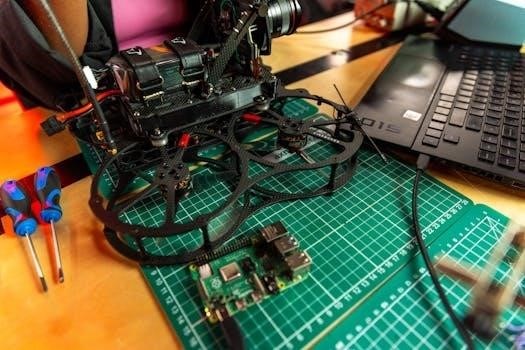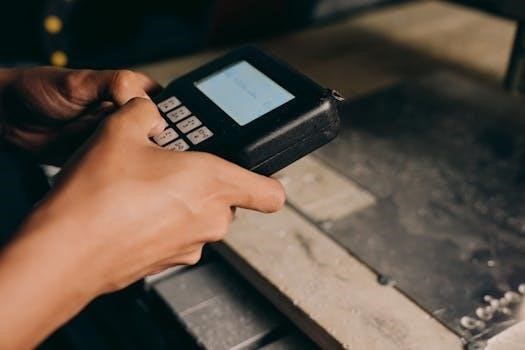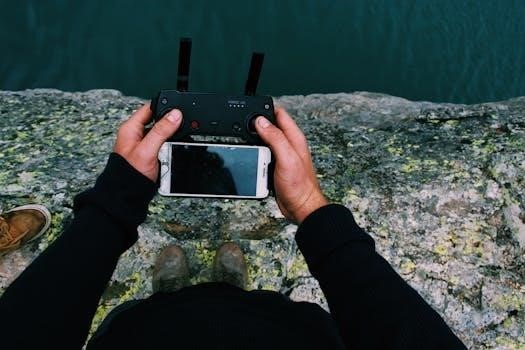
User manuals for solar charge controllers are essential for safe and efficient operation․ These documents provide vital information on installation, settings, and troubleshooting, ensuring optimal performance and longevity of your solar power system․
Understanding the Importance of User Manuals
User manuals are critical for solar charge controllers because they provide essential safety, installation, and operational guidelines․ These manuals are not just a formality; they are a crucial resource for understanding how to connect, configure, and maintain your controller properly․ By following the detailed instructions, you can prevent damage to your equipment, avoid potential safety hazards, and maximize the efficiency of your solar power system․ These manuals often include specific wiring diagrams, recommended settings for various battery types, and troubleshooting tips, which are indispensable for both new and experienced users․ Understanding the importance of the manual ensures the long-term performance and reliability of your solar investment․
Types of Solar Charge Controllers
Solar charge controllers are primarily divided into two types⁚ PWM (Pulse Width Modulation) and MPPT (Maximum Power Point Tracking), each with distinct operational characteristics and suitability․
PWM (Pulse Width Modulation) Controllers
PWM controllers, often more affordable, function by connecting the solar panel directly to the battery, using rapid on-off switching to regulate the charge․ This process, known as pulse width modulation, adjusts the duty cycle of the switch to control the amount of power delivered to the battery․ While straightforward, PWM controllers are best suited for smaller systems where the solar panel voltage closely matches the battery voltage․ They are generally less efficient than MPPT controllers, particularly when there is a significant difference between the solar panel’s voltage and the battery’s voltage․ Therefore, careful consideration of system compatibility is essential when choosing a PWM controller․ These controllers are commonly used in basic off-grid setups and for charging individual batteries, offering a cost-effective solution for simpler applications․
MPPT (Maximum Power Point Tracking) Controllers
MPPT controllers are advanced devices that optimize the power transfer from solar panels to batteries by constantly adjusting the operating point of the solar array to its maximum power point․ This technology allows MPPT controllers to harvest more energy from the panels, particularly when voltage differences exist between the panels and the battery․ They are highly efficient and especially beneficial in situations where solar panel voltage is significantly higher than the battery voltage, such as in larger systems․ MPPT controllers also offer more sophisticated charging algorithms, which can extend battery life and provide better overall system performance; While more expensive than PWM controllers, their increased efficiency makes them a valuable investment for maximizing solar energy capture, especially in complex or high-power applications․

Key Components and Functions
Solar charge controllers typically include components for regulating voltage and current, managing battery charging stages, and providing safety features․ They ensure efficient and safe solar power system operation․
Battery Charging Stages
Solar charge controllers employ multiple charging stages to optimize battery health and performance․ The initial stage, known as bulk charging or constant current, rapidly charges the battery using maximum available current․ Following this, the controller enters the absorption or constant voltage stage, maintaining a consistent voltage to bring the battery to a full charge․ Once fully charged, the controller switches to a float stage, where a reduced voltage maintains the battery at its full capacity without overcharging․ These stages are crucial for prolonging battery life and ensuring optimal performance within a solar power system, preventing damage and maximizing energy storage․
Safety Features and Protections
Solar charge controllers incorporate crucial safety features to protect both the battery and the system․ Overcharge protection prevents damage from excessive charging, while over-discharge protection safeguards against deep discharges that could harm the battery․ Short-circuit protection is also essential, quickly stopping current flow in the event of a short circuit․ Reverse polarity protection prevents damage if the battery is connected incorrectly․ Additionally, some controllers feature over-temperature protection, shutting down operation if components overheat․ These built-in safeguards ensure reliable and safe operation of the solar power system, preventing costly damage and extending the lifespan of system components․ Proper installation, in accordance with the manual, is vital for optimal safety․

Installation Instructions
Proper installation is critical․ Follow the user manual’s wiring diagrams carefully, connecting solar panels, batteries, and loads correctly․ Always observe safety precautions to avoid damage or injury during installation․
Wiring Connections (Solar Panels, Battery, Load)
Connecting your solar charge controller correctly involves a specific sequence and proper wiring techniques․ First, connect the battery to the controller; this allows the controller to identify the system’s voltage․ Next, attach the solar panels to the designated input terminals, ensuring correct polarity․ Finally, connect the load to the appropriate output terminals if your controller supports load management․ Always use appropriately sized wiring and fuses or DC breakers between the solar panel, the controller, and battery for safety and protection․ The manual often contains detailed diagrams illustrating these connections, showing the order of connection and cable sizes․ Never skip the step of reviewing the diagram to avoid issues․
Safety Precautions During Installation
Before beginning any installation, always read the entire user manual thoroughly․ Ensure the system is powered down before making any connections․ Use appropriate personal protective equipment, like safety glasses and insulated gloves․ Verify that all wiring is correctly polarized and that connections are secure to avoid shorts or fires․ Install a fuse or circuit breaker between the solar panel and the controller․ If you are uncertain about any aspect of the installation, consult a qualified professional․ Never touch live wires and always respect the voltages you are working with․ Keep the installation area clear of obstructions․ Always have a safe place to do your work․

Operation and Settings
Understanding the operation and settings of your solar charge controller is crucial․ This section covers adjusting charging parameters and interpreting LED indicators for optimal system performance․
Adjusting Charging Parameters
Solar charge controllers allow users to fine-tune charging parameters to match their specific battery type and system requirements․ These parameters often include bulk charging voltage, float voltage, and equalization settings, all of which are critical for battery health․ The user manual will specify the acceptable voltage ranges and provide guidance on setting these values․ It is essential to refer to your battery manufacturer’s specifications for recommended charging settings․ Incorrect settings can lead to undercharging or overcharging, which may reduce battery life or cause damage․ Some controllers also offer adjustable low voltage disconnect settings, which prevent over-discharge and extend battery lifespan․ Carefully consult your specific controller’s manual for the correct adjustments․
Understanding LED Indicators
LED indicators on a solar charge controller provide a quick visual status of the system’s operation․ These indicators typically display charging status, battery voltage level, and any fault conditions․ A solid green light might signify a fully charged battery, while a flashing light could indicate charging in progress․ Specific patterns of flashing lights often correspond to error codes․ The user manual provides essential details about what each LED color and pattern means, allowing users to quickly understand the system’s current state․ Always consult the manual to properly interpret these indicators for optimal system monitoring․ Different controllers will have various LED patterns․

Troubleshooting
Troubleshooting a solar charge controller involves identifying common issues, interpreting error codes, and finding solutions to ensure the system is working correctly, as detailed in the user manual․
Common Issues and Solutions
Common problems with solar charge controllers include underperforming solar panels, which can be due to shading or incorrect wiring․ Another issue is a charge controller not reaching full output which may be related to low battery voltage or high temperature․ It is important to check the connections between the solar panels, battery and controller․ Also ensure the correct battery type is selected for your controller․ The manual also often provides solutions for overcharging or reverse current issues․ By carefully following the user manual’s instructions you will be able to identify and resolve many issues․ If you have difficulties, contact the manufacturer’s tech support․
Interpreting Error Codes
Solar charge controllers often display error codes to indicate specific problems․ These codes, detailed in the user manual, are essential for diagnosing and resolving issues․ For example, a code might signify an overvoltage, a short circuit, or a battery problem․ The manual will explain each code’s meaning and suggest troubleshooting steps․ It is crucial to consult the manual for the specific error code you are seeing, as codes vary between models․ Ignoring error codes can lead to system damage and reduced performance․ Proper understanding of the error codes in your controller manual will allow you to quickly diagnose and fix issues․